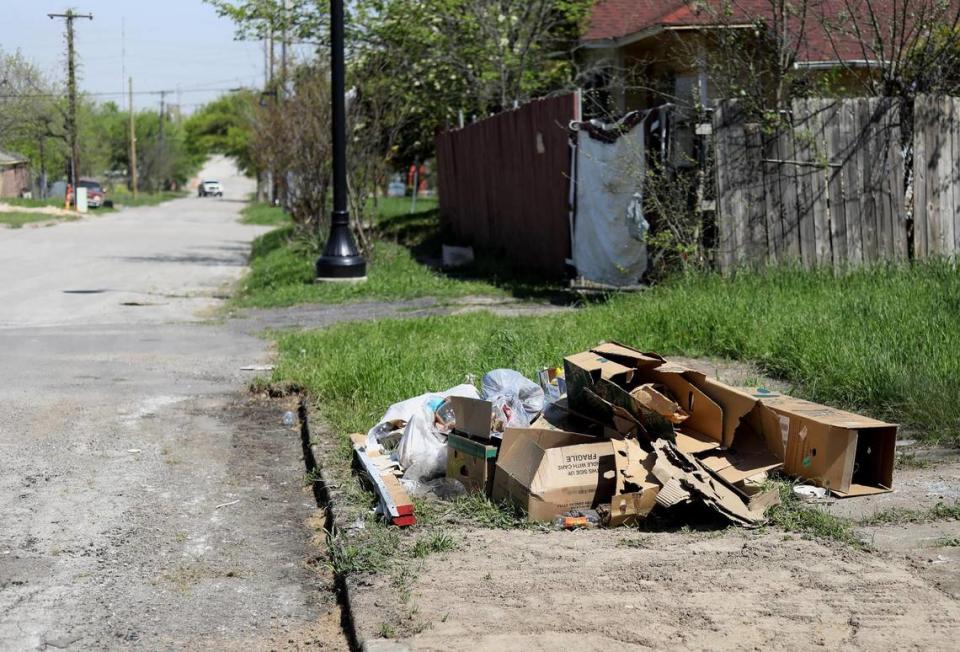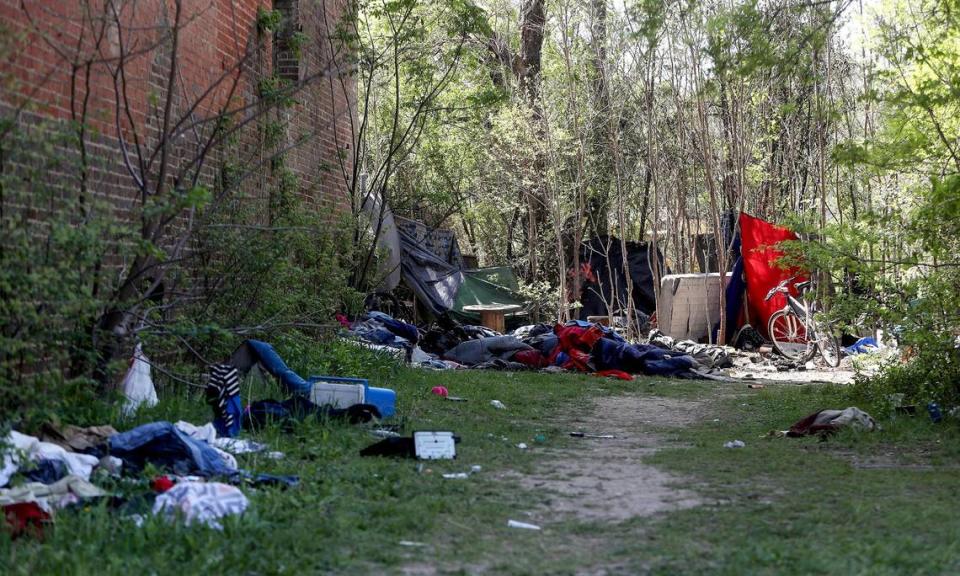‘No one cares.’ Litterbugs mar this proud Fort Worth neighborhood with piles of trash
Johnny Lewis’ his pride swells when he looks at his neighborhood.
He sees the hard work he and his late wife put into their home. He sees his neighbors working on their manicured lawns. He sees the rich history of the Historic Southside community.
But when he looks closer he sees trash: Garbage bags dumped in the vacant lot down the street. Clothes strewn across a former homeless camp. Cardboard boxes and milk jugs dumped on the curbs.
In a place where pride is found around nearly every corner, abuse is dumped there, too.
“The bad part about it is people from outside come in and they see this and think the people from the Southside don’t care about their neighborhood and they don’t understand we clean,” Lewis said. “People don’t want to take trash to the city dump so they’ll come from the outside and dump it here.”
Lewis and his neighbors, Jherre Williams and Wallace Bridges, recently took a Star-Telegram reporter and videographer on what they called a “trash tour” to show what they’re fighting against. They showed dozens of corners filled with trash bags and cardboard boxes and trash and wet clothes abandoned at former homeless camps.
Almost every Sunday morning, Williams takes her own trash tour. She photographs new piles and reports them on the “MyFW” app, she said. There were more than 160 trash and solid waste complaints reported in Historic Southside from November 2020 to March.
It feels like an endless cycle. Residents report the trash. Code compliance picks it up. Trash is dumped again. Residents report the trash.
“It feels like we’re the only ones who care,” Williams said.
Though the issue of illegal dumping is one leaders see citywide, Brandon Bennett, department head of Fort Worth’s code compliance, said he recognizes the overwhelming issue of it in Historic Southside. But what makes their neighborhood an easy dump site?
When asked that question, Lewis dropped his head and said, “Why do you think?”
Bennett said areas with vacant lots (of which there are dozens in Historic Southside) are more likely to be the site of illegal dumping, but that the issue is complex.
“There’s no single answer to why we see so much litter and illegal dumping in one area of town versus another,” he said on Wednesday. “In some cases, neighborhoods are very active and pay attention so when someone illegally dumps and they dial 911.”
Williams, Lewis and Bridges are trying to be those proactive residents, but every time they make progress, another pile is found.
‘No one cares’
The perception that the residents in Historic Southside, a majority Black area of Fort Worth, don’t care about their neighborhood bothers Lewis.
“We’ve done neighborhood cleanups where we’ve cleaned this whole area,” he said while standing outside of the Southside Community center. “Because someone else doesn’t care, they come in and dump. But it looks bad on us.”
Lewis has broken open discarded trash bags to see if he could find addresses of where it might’ve come from. That’s why he thinks the majority of the dumping is coming from people who don’t live in the neighborhood. It’s a trick he said he learned from the area’s last code enforcement officer.

“It’s very frustrating to live in a community where I’m looking at the children walking to school and they’re going past this trash,” he said. “It tells them they don’t live in a good place.”
The residents say that trash sometimes sits there for weeks at a time, but Bennett disputes any claims that reports made through the app are ignored for that long.
“We have crews that get it within 72 hours,” he said. “It’s not true when people say they report it and it’s not cleaned up. There’s no benefit to not clean it up. What happens is we clean it up and they might go look at the area again and see a different pile.”
Kelly Allen Gray, the councilwoman for District 8, also acknowledged that trash dumping is an issue for the area (and for 76104 neighborhoods that extend beyond Historic Southside).
“Not only have I received complaints, I’ve made my own,” she said. “One of the things that I do is that I ride through my different neighborhoods and I use the MyFW app an awful lot.”
Gray said her office tries to stay ahead of the trash issue, but with difficulty.
“If you look along East Lancaster, we have trashcans out and they are full and overflowing and the trash is on the side,” she said. “I think it’s a matter of it’s accumulating and how quickly are we getting it picked up.”
Homeless camps in the neighborhood
When Lewis turned his SUV onto the 1600 block of Leuda Street, a green house came into sight. Its lawn was a little overgrown but otherwise the outside of the house was clean.
But right next to the property, a tent stood on a vacant lot. Outside the tent there was a stroller, a scooter, a vacuum cleaner, a cooler and other appliances that had been discarded among smaller trash items.
A woman two doors down recently moved to the neighborhood from Chicago, Lewis said.
“People shouldn’t have to buy a house and live like this,” he said.
Gray said the neighborhood’s close proximity to the services on East Lancaster has made residents there ”the unfortunate beneficiaries of unsightliness and the illegal dumping and just trash everywhere.”
One problem everyone agreed on is that well-meaning people will visit homeless camps to distribute food and clothes, but the donations eventually become litter.
Lauren King, executive director of the Tarrant County Homeless Coalition, said there are better ways for Fort Worth residents to help those communities in need and she agrees with Lewis about the burden of trash left behind.
“We try hard to engage with groups who want to give back,” she said. “There are a lot of well meaning people but ultimately three meals a day are available for everybody experiencing homelessness. Food is not a need.”

King said the coalition tries to match church and civil groups who want to hand out food and clothes with groups who already partner with the coalition to make sure donations are going to the appropriate places that don’t lead to litter. Two coalition employees will travel around areas where people experiencing homelessness most often stay to find those groups and redirect their efforts.
“A lot of time when we engage with people and redirect their giving, we ask them to rethink how they do that, they’re not interested in that,” she said “It’s interesting that they don’t want to do what’s actually needed. If you’re not really interested in what’s needed, then what’s the point of your giving?”
On any given day, King said there are 400 to 600 people living outside and only 11 people on their street outreach team. Through the CARES Act, they were able to increase that number, but contacting everyone who doesn’t have shelter is still difficult. And some people don’t want shelter, she said.
Redevelopment could be a solution
Bennett said the city has taken measures in the past to stop illegal dumping, including monthly bulk pick-up days and the addition of drop-off dumping sites.
However, one solution is to redevelop areas filled with vacant lots.
“The challenge in many underdeveloped areas and with the high transient population is that we’ll continue to see this until some redevelopment occurs,” he said. “The best example of this is the Fairmount area.”
Around 2004, Bennett said illegal dumping was worse in Fairmount than it is now in Historic Southside. But redevelopment of the neighborhood, including the hospital district and Magnolia Street occurred.
“That got a lot of homeowners and more pride in the property, and then we saw less illegal dumping,” he said.

